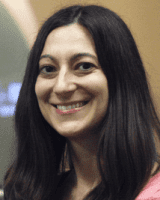Congratulations to Julie Golomb, the VSS nominee and recipient of the 2019 Federation of Associations in Behavioral & Brain Sciences (FABBS) Early Career Impact Award.
The FABBS Early Career Impact Award honors early career scientists of FABBS member societies during the first 10 years post-PhD and recognizes scientists who have made major contributions to the sciences of mind, brain, and behavior. The goal is to enhance public visibility of these sciences and the particular research through the dissemination efforts of the FABBS in collaboration with the member societies and award winners.
 Julie Golomb
Julie Golomb
Associate Professor
Ohio State University
Julie Golomb earned her bachelor’s degree in neuroscience from Brandeis University and her doctorate from Yale University. She completed post-doctoral research at MIT before joining the faculty at Ohio State in 2012 and receiving tenure in 2018. Her lab’s research is funded by grants from the National Institutes of Health, the Alfred P. Sloan Foundation, and the Ohio Supercomputer Center. For more information about Dr. Golomb and an overview of her article, go to Making Sense from Dots of Light on the FABBS website.
Making Sense from Dots of Light
For Julie Golomb, it all started with a college course in visual perception. “I realized that all of these things I take for granted about how I perceive the world are actually really hard challenges for the brain to solve.”
How do we recognize our coffee mug? How do we pick out a friend’s face in the crowd? Or know that the round, white and black thing flying at us is, in fact, a soccer ball?
This constant bombardment of rich and usually moving pictures start out simply as dots of light hitting different spots on the retina.
Those dots create a map of where things are in the world before heading to the brain, where the deep processing takes place that Golomb studies in her lab.
While the brain is busy almost instantaneously processing incoming data, the world outside is continuously moving and changing, as are our eyes–an emphasis in Golomb’s lab.
In one experiment, Golomb may ask volunteers to determine whether two objects that appear on a computer monitor are the same shape. “Or we’ll flash a bunch of different objects on the screen and then ask, ‘What color was presented in a certain location?’”
Among interesting findings: When asked to pay attention to two squares of different colors, such as red and blue, volunteers might mistakenly describe one of the colors afterward as purple.
“The brain has a hard job, and it does a remarkable job,” Golomb says. “But it is not perfect.” A lot of learning about the brain is based on its mistakes.
Golomb also asks volunteers to complete tasks while connected to tools such as functional MRI, which images their brain, or an EEG machine, which records electrical activity on the scalp. She uses sophisticated computer models to analyze how the brains are processing information.
As the technology changes and develops, so do the possibilities with brain research. And it’s not just new equipment. “We’re asking better questions and new questions based on what we’re continually learning.”
 Julie Golomb
Julie Golomb